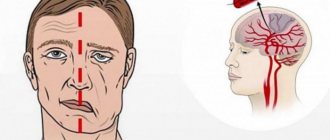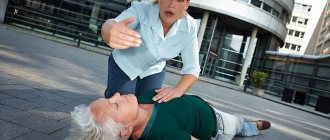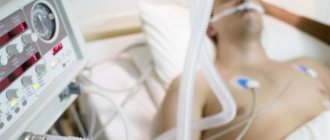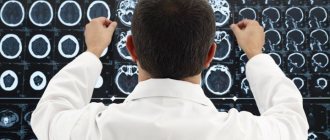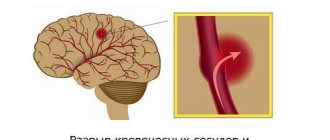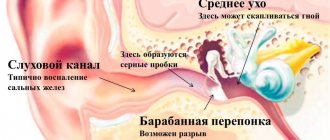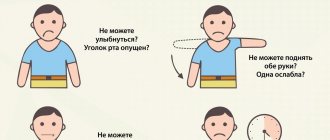Hypertension and stroke often go hand in hand, as constant exposure to pressure reduces the degree of elasticity of blood vessels.
Their walls become thinner, cracks appear on them and atherosclerotic plaques grow. They disrupt blood flow, as a result of which the tissues lack nutrition and necrosis begins. Any sudden increase in pressure in such a situation can cause the plaque to rupture. It can completely block blood flow or rupture the wall of a vessel. The hemorrhagic form of stroke caused by hypertension is a rupture of a cerebral vessel. From it, up to 50 or more ml enters the brain. blood, which thickens, pushes away the surrounding tissue and forms a hematoma. If the patient has not received assistance within 3-4 hours from the moment the vessel wall breaks, then the affected areas begin to die. This process generally leads to death and severe disability.
Long-term hypertension often leads to ischemic stroke. This is due to the gradual wear and tear of blood vessels due to pressure, which impairs cerebral circulation. Long-term development of ischemic stroke leads to the death of brain cells and gradual loss of ability to work.
At what pressure a stroke can occur is not easy to answer, because it can develop even with hypotension due to the negative effect on the blood vessels. However, the starting point for the manifestation of the disease is often a hypertensive crisis. It is a condition in which a person’s blood pressure rises sharply above 180/140 mmHg. Art. Such a jump leads to rupture of blood vessels and hemorrhage in the brain.
Types of disease
Stroke is a pathology accompanied by impaired blood circulation in certain areas of the brain. The condition is accompanied by oxygen starvation and a severe deficiency of nutrients, which ultimately leads to the death of brain cells. As a result, there is a complete or partial loss of functions for which the affected area was responsible.
Depending on the underlying cause, there are two types of stroke:
- Ischemic (most common). It is a consequence of blockage of the lumens of cerebral vessels. The disease progresses slowly and is not accompanied by hemorrhage, but is accompanied by the death of brain cells.
- Hemorrhagic. Caused by hemorrhage in the brain tissue as a result of rupture of a local vessel. Due to the accumulation of blood and pressure exerted on a certain area of the brain, its functions are impaired.
Important! The cause of a stroke may be cerebrovascular disease.
Symptoms, signs and first aid
Anyone can have a stroke, which is why it is so important to know the primary symptoms of the condition. It is indicated by:
- weakness in the limbs;
- fainting conditions;
- numbness of half the face, distortion of features;
- Strong headache;
- speech impairment, misunderstanding;
- various visual impairments;
- complete or partial paresis;
- impaired coordination of movements up to its complete loss;
- impaired skin sensitivity;
- instability and tension of the pulse.
If we talk about what pressure is possible during a stroke, then its indicators can be both low and high. To make sure that the patient has had a stroke, he must be asked to perform several familiar actions. For example, smile broadly or say a few words. He will not succeed: the affected part of the face will remain motionless, and speech will be unclear, as if the person’s mouth is filled with porridge and he is trying to speak through it.
What to do if this happens? First of all, immediately call an ambulance. Lay the patient down so that the head is elevated in relation to the legs, unbutton the collar, and remove the woman’s bra. A person must breathe deeply. Trying to lower blood pressure on your own is strictly prohibited.
Signs of a stroke
1. Facial asymmetry
The sign that first catches your eye. If you have a stroke, you may experience sudden numbness and tingling on one side of your face.
2. Numbness of the limbs
Most often, muscle numbness occurs on only one side. The muscles do not obey, the person cannot lift an arm or leg.
3. Speech impairment
Speech becomes incoherent, confused, and a person may not understand what is being said to him.
4. Loss of coordination
You need to be wary of sudden dizziness, accompanied by imbalance, loss of balance. The person loses the firmness of his gait and has problems with coordination.
5. Severe headache
It is unbearable and may be accompanied by vomiting. The pain occurs for no reason and does not decrease when taking painkillers.
6. Vision problems
Clarity is lost, objects begin to appear double. One or both eyes can lose good vision at once.
What blood pressure can trigger the development of a stroke?
At what blood pressure level can a stroke occur and can the condition develop at normal blood pressure? It is worth noting that most often a stroke occurs in hypertensive patients. The reasons are:
- Stably high blood pressure, which does not decrease even while taking medications;
- sharp jumps in indicators caused by a stressful situation or significant physical activity;
- refusal of treatment for hypertension and heart disease.
Doctors call the physiological level of blood pressure, at which all body systems operate in a natural mode, a level of 120/80 mm. rt. Art. When it increases to 180/120, we can talk about the development of a hypertensive crisis, which can quite easily turn into an apoplexy (stroke).
The danger in terms of the development of pathology is represented by too small a difference between the upper and lower blood pressure readings. If it is less than 40 units, then the likelihood of blockage of the vascular lumen increases significantly. Therefore, a blood pressure of 130/110 is more likely to trigger the development of a stroke than a blood pressure of 160/90.
No ads 1
Risk factors
Very high blood pressure virtually always brings a person to the hospital. After the examination, the doctor will be able to tell how high the chances of a stroke due to the development of hypertension are. In his forecasts, he focuses on the following factors:
- Patient's age. The dangerous line for men is after 55 years, and for women - 65.
- Weight. Excess body weight is an important causative factor for vascular blockage.
- Heredity. If there were people in the family with strokes and hypertension, then the chances increase significantly.
- The amount of cholesterol in the blood. A bad indicator is considered to be 6.5 mmol/l. and higher.
- Abuse of bad habits. Smoking, alcoholism, and drug addiction negatively affect blood vessels and the body as a whole.
- Passive lifestyle. Low physical activity leads to excess weight and the development of other pathologies.
- Endocrine disruptions, for example, diabetes. A high concentration of sugar destroys blood vessels, which, together with hypertension, can quickly lead to a stroke.
After identifying arterial hypertension and factors that provoke the development of stroke, the doctor can assess the degree of risk, namely:
- First. The patient does not have any provoking factors or does have them, but no more than 1. The chances of developing the disease are difficult to assess; usually they do not exceed 10% in the next 10 years of life.
- Second. The doctor found 1-2 factors influencing the development of the disease. In the next 10 years of life, the chance of developing a stroke is 15-20%.
- Third. A person has 3 causative factors and the chance of developing pathology in the coming years is 20-30%.
- Fourth. The patient was diagnosed with 4 factors. According to statistics, the chances of developing various complications, including stroke, in the next 10 years of life are 30% or higher.
Acceptable indicators and pressure deviations after impact
What blood pressure should a patient have after a stroke? Everything will depend on the type of pathology.
Ischemic form
During the first few hours after the formation of the condition, almost all patients experience high blood pressure. This is a protective reaction of the brain aimed at stabilizing the work of the myocardium. That is why a specialist should select antihypertensive drugs, taking into account the current condition of the patient.
Incorrectly selected medications can reduce blood pressure too much. The worst outcome in this case may be the death of a person. In addition, recovery after a stroke will be longer and more difficult.
Indications for emergency reduction of blood pressure are:
- increase to 180/220–100/120 mm. rt. st;
- the need to administer an antithrombotic agent;
- development of systemic circulatory failure;
- diagnosing aneurysm/arteriovenous malformation of cerebral vessels;
- disorders of the kidneys.
During the first 48–72 hours after an ischemic stroke has occurred, blood pressure can be reduced by no more than 15% relative to the existing one. At this time, increased blood pressure is normal.
Important! In patients who do not have a history of hypertensive pathology, blood pressure should not fall below 165/95 mm. rt. Art. In the presence of the disease, the minimum level is determined by 185/105 mm. rt. Art.
It is very important to protect the patient from factors that can provoke a sharp increase in blood pressure. These include nervous tension, severe pain, and fluid retention.
Hemorrhagic form
This type of stroke occurs against the background of a significant increase in blood pressure, so antihypertensive therapy should be started as early as possible. Taking medications helps:
- reducing the volume of the hematoma, stopping its spread;
- decrease in intracranial pressure;
- blocking the development of swelling of brain tissue.
The critical level of blood pressure, upon reaching and overcoming which it is necessary to take measures to reduce, is considered to be 140/90 mm. rt. Art. But the decline should be gradual. During the day, it can be lowered only by 20% relative to the current one.
No ads 2
Low and high blood pressure
During the first 24 hours after the impact, maintaining high blood pressure is an acceptable norm. The danger is high blood pressure that persists for a week after a stroke. The symptom indicates incorrect treatment. In this case, the patient becomes incapacitated and develops neurological disorders.
Such negative consequences for the patient’s health are due to the continuing increase in cerebral edema, which results in wedging of the brain stem into the occipital part. It is possible that breathing processes may be disrupted until a critical condition develops, as well as heart failure and cardiac arrest.
Complications of hypertensive crisis
If the pressure, despite the therapy, still jumps, then the consequences may be as follows:
- re-strike;
- expansion of the ischemic focus;
- development of encephalopathy;
- hemorrhage in the skull.
Why does a patient have low blood pressure after a stroke and why is this condition considered negative by doctors? A rapid decrease in blood pressure occurs against the background of the following pathological conditions:
- development of a major stroke;
- brain stem damage;
- the formation of cardiogenic shock against the background of a heart attack;
- heart rhythm disturbance;
- dehydration;
- blockage of the pulmonary arteries;
- blood poisoning;
- aneurysm.
Low blood pressure values during the rehabilitation period indicate progression of the pathology. The prognosis in this case is extremely unfavorable, this applies to both recovery and human life. A decrease in blood pressure can occur against the background of regular use of hypertensive drugs that were prescribed to the patient even before the stroke developed.
But if the reason for this is not drug treatment, then this is a signal that the body is unable to independently regulate blood pressure as a result of impaired cerebral blood circulation. Medical statistics show that severe hypotension during the first few days after a stroke causes the death of the patient.
No ads 3
Features of hypertensive strokes
Blood pressure and hypertensive stroke have a direct relationship, and many people have learned this from their own experience. If treatment is not started in a timely manner, areas of impaired blood circulation in the brain will affect the occurrence of certain neurological symptoms. In each individual case, patients manifest hypertensive stroke in their own way. In total, 4 forms of the disease can be distinguished:
- First form. The patient loses consciousness for a short period of time and has problems coordinating movements. Sometimes visual impairment occurs, such as double vision.
- Second form. A person's muscles weaken and sensation is lost on one side of the body.
- Third form. In this case, half of the body is completely paralyzed, and bulbar disorders occur.
- Fourth form. It occurs with severe hemorrhage. The patient loses consciousness, and in the absence of help, rapid death is possible due to serious impairment of brain functions.
Causes of blood pressure surges
A sharp fluctuation in blood pressure after a stroke occurs when the organs and systems of the body are unable to perform their functions. Most often it is the brain that is affected. Against the background of unstable blood pressure, both cardiac and peripheral circulation worsens, and the destruction of the walls of blood vessels also occurs. The patient develops an acute form of atherosclerosis. The development of recurrent strokes cannot be ruled out.
The main danger lies not in the increase or decrease in pressure, but in its constant fluctuation
The leading causes of sudden changes in blood pressure that occur after a stroke are:
- disturbances in the functioning of the central nervous system;
- low mobility of the vasomotor center;
- high blood sugar levels;
- hormonal imbalance;
- changes in the electrolyte composition of the blood.
Important! With a hemorrhagic stroke, the risk of developing a second stroke is high. This usually happens on the fifth or sixth day after the first blow.
Stroke in hypotensive patients
The development of a stroke is also possible with low blood pressure (in people suffering from hypotension). The formation of pathology is due to the body’s inability to independently eliminate the impending blow. A stroke in hypotensive patients can be triggered by features of a person’s lifestyle, stressful situations, disturbances in the functioning of internal organs and systems as a whole, and the use of antihypertensive medications.
The cause of stroke development against the background of hypotension can be:
- a sharp increase in blood pressure - occurs as a result of severe stress, overwork, as a side effect of the drug;
- rupture of an aneurysm - can be triggered by lifting weights, staying in a prolonged inclined position in hot rooms or under the open sun - a violation of the integrity of the vessel occurs as a result of overstrain;
- bleeding disorder - in this case, the likelihood of blood clots and blockage of blood vessels in the brain increases.
In the chronic form of hypotension, the likelihood of developing an ischemic stroke increases significantly with age. In the presence of cardiovascular pathologies, the risk of hemodynamic stroke increases. This is a subtype of the ischemic form, caused by circulatory decompensation. Its cause may be:
- atrioventricular block;
- myocardial infarction;
- weak sinus syndrome;
- atrial fibrillation.
Parkinson's disease is often accompanied by hypotensive crises, which, in turn, can cause the development of hemodynamic stroke. In hypotensive patients, signs indicating the formation of a hemorrhagic form of stroke are almost completely absent.
The condition is characterized by a slow onset and a long period of persistence of symptoms of brain damage with low blood pressure. The patient does not experience loss of consciousness or headaches. But almost all the precursors are typical for ischemic stroke. Most often, symptoms occur at night or in the morning.
[node:field_similarlink]
What's happened
A stroke is a sudden disruption of the normal blood supply to the brain.
Based on the nature of the disorders, there are two main types of stroke: ischemic (often called cerebral infarction) and hemorrhagic (including subarachnoid hemorrhage). This article will talk about ischemic stroke, which is 4 times more common than hemorrhagic stroke. The word “ischemic” literally means that there is not enough blood flowing to one or another organ - with such a stroke, blood does not flow to the brain due to blockage or severe narrowing of the main arteries. As a result, brain tissue cells die.

